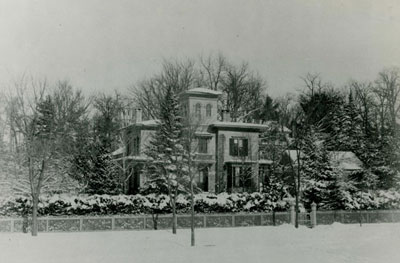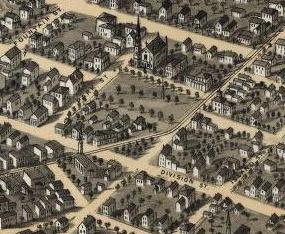About twenty miles south of the
Thomas D Gilbert, Sr home in Greenfield, Massachusetts is the town of Amherst. In Amherst lived the
Edward Dickinson family, consisting of Edward, his wife, Emily, and children, Austin, Emily, and Lavinia. Interestingly, these two families were connected, back 5 and 6 generations, but that is not unusual in early New England. Edward's father,
Samuel Fowler Dickinson, sunk a lot of money into Amherst College when it was founded, and suffered financial losses because of it. He had to take a job at a college in Ohio, selling the house he had built, called
The Homestead. Most of the Dickinson family moved with him to Ohio, except son, Edward, Emily's father. He became the Treasurer of Amherst College, and eventually bought back
The Homestead in 1855. In 1856, son Austin married
Susan Huntington Gilbert. . .
My last post covered the Gilbert brothers, Thomas and Francis. But there were four Gilbert sisters, one of whom came to Grand Haven, and then to Grand Rapids with her brothers. There seem to be quite a few members of the combined Gilbert family that moved to Grand Haven at the same time as Thomas and Francis, but this will only document the immediate family.
Mary Arms Gilbert was born 1 July 1822 in Greenfield, Franklin, MA, and married 19 September 1849 to
Samuel Julius Learned in Amherst, Hampshire, MA. They had probably met at Amherst College, where Samuel graduated in 1845. Samuel was a schoolteacher, and it is not known how long the family lived in Grand Haven, but their only child,
Mary Gilbert Learned was born there 19 June 1850.
Mary Arms Gilbert Learned died of complications from childbirth on 14 July 1850 and was buried in
Fulton Street Cemetery in nearby Grand Rapids. Interestingly, her husband was teaching in North Carolina right after their marriage, so Mary must have wanted to be near family when she gave birth. I can't find either Mary or Samuel on the 1850 census, however.
I don't have a picture of Mary, but here's her daughter,
Mary Gilbert Learned, who was born 19 June 1850, reportedly in Grand Haven, Michigan, from her 1923 passport.
~~~~~~~~~~~~~~~~~~~~~~~~~~~~~~
Mary's older sister was
Harriet Murray Gilbert, born 18 June 1820 in Greenfield, Franklin, MA and married
William Cutler, a merchant, in Amherst 4 June 1842. She spent her life in Amherst, dying
18 March 1865, at age 45. She took in her two youngest sisters when their parents died in 1836 and 1841.
Emily Dickinson wrote a poem to
Susan Huntington Gilbert Dickenson when she learned of Harriet's death.
Dear Sue --
Unable are the
Loved -- to die--
For Love is immortality --
Nay -- it is Deity --
Emily.
~~~~~~~~~~~~~~~~~~~~~~~~~~~~~~
Martha Isabella Gilbert was born 13 April 1827 in Greenfield, Franklin, MA, married
John Williams Smith 20 October 1857 in Amherst, Hampshire, MA and lived in Geneva, Ontario, NY, where her husband ran a dry goods store. He died in 1878 and
she died in 1895. She was a good friend of
Emily Dickinson, along with her younger sister, Susan, and they were frequently called the "Gilbert Twins".
Austin Dickinson, Emily's brother, entertained thoughts of marriage with Martha, but changed his affections to Susan.
~~~~~~~~~~~~~~~~~~~~~~~~~~~~~~
Susan Huntington Gilbert was born 19 December 1830 in Deerfield, Franklin, MA, married
William Austin Dickinson, the poet,
Emily Dickinson's brother, 1 July 1856 in Geneva, Ontario, NY, and died 11 May 1913 in Amherst, Hampshire, MA. They had 3 children--
Edward Austin, an epileptic, who died at age 31 while engaged to be married,
Martha Gilbert, who married a shady Russian officer named
Capt. Alexander Emmanuel Bianchi, and divorced him after 1913, and
Thomas Gilbert, who died of typhoid fever at age 8.
Susan and Austin briefly considered moving to Chicago to be near her brothers, but
Edward Dickinson, Austin's father, persuaded them to stay by making Austin a law partner, and building them a home next door to his in Amherst, called
The Evergreens, and helping them furnish it, along with a generous dowry from
Francis and Thomas Gilbert.
Frederick Law Olmsted landscaped their grounds and was a frequent visitor. Undoubtedly,
Thomas and Francis Gilbert knew him, too. I wonder if they ever persuaded him to come to Grand Rapids?
Susan had been a math teacher before she got married and possessed a powerful intellect, was a prodigious reader, and a prolific writer. She was the first reader of
Emily Dickinson's poems and offered criticism and inspiration to her for the 40 years that they knew each other. There has been a lot of speculation on what their relationship entailed, but I leave you to draw your own conclusions.
Emily Dickinson was "ill" for most of her life, and a recluse from society, except close family. There is a strong possibility that she was epileptic, as that condition ran in her family, and would have precluded any possibility of marriage for her, as marriage and childbirth were thought to be too "exciting" for women with epilepsy. Her sister, Lavinia, also remained unmarried, and cared for Emily after their parents died.
It is speculated that Susan really didn't want to marry Austin, as she was debilitated in 1850 when sister Mary died as a complication of childbirth. Susan became ill in 1854, shortly after a proposal from Austin, and went "west" to visit her brothers in Grand Haven for 6 months. Austin eventually came to get her, and shortly after she returned home, another wedding date was set and followed through. Marriage was, at that time, the expected future for women, and to live as a single woman was frowned upon and difficult. Being an orphan, Susan felt pressured to get married, and, as Austin had excellent financial prospects, was as good a choice as any. Not to say there was love there, also, but that changed.
The marriage was rocky, as Austin was dry and severe, as was his father before him. Susan got into the social whirl and had many visitors to her home, including
Ralph Waldo Emerson,
Harriet Beecher Stowe, Calvert Vaux, and
Frederick Law Olmstead, and was welcoming to strangers, which unfortunately led to the loss of her husband's love.
Mabel Loomis Todd, a young woman married to a teacher at Amherst College, was Susan's friend first, and rapidly became a frequent visitor, but from the very start, had designs on
Austin Dickinson. In 1882 he took her as his mistress and carried on a 13-year relationship, using the Dickinson family home,
The Homestead, for their assignations, with the implied consent of Lavinia and Emily. In fact, Emily would never meet Mabel face to face during her life. She and Lavinia were constrained from objecting as they looked to Austin, as they had to their father, as the head of the family, and their protector, being both single women. Neither couple divorced. This whole affair, and how it affected the lives of the entire Dickinson family is well documented.
Susan was also an accomplished
writer and publisher of stories, poems, and articles throughout her life.
Here is a poem Emily wrote for Susan:
To own a
Susan of
my own
Is of itself
a Bliss--
Whatever
Realm I
forfeit, Lord,
Continue
me in this!
Emily
When Austin and Susan were anticipating their home together, brother
Thomas Dwight Gilbert sent a drawing to the couple of a proposed house. This
prompted Austin to announce he didn't "like handsome houses--home-ly houses are my kind, rather plain, [ample?] comfortable looking suggesting repose wealth and yet independence of wealth. Still, intrigued by Dwight's "brilliant" plan,. he was willing to consider "an angle or two better than has yet been done in G.R.[Grand Rapids] domestic architecture." It isn't known whether the house as built, an up-to-date Italianate villa with a flat-roofed tower, wide porch, and "angles" galore, was based on the Michigan design.
Quote from "My Wars Are Laid Away in Books", Alfred Habeggar, 2001, Random House
Brother
Francis Gilbert chose the Italianate style when he built his own house, but Thomas went in another direction with his,
across the street.
The three books I read about Emily and Susan are the above,
"My Wars. . . ";
"Open Me Carefully, Emily Dickinson's Intimate Letters to Susan Huntington Dickinson", edited by Ellen Louise Hart and Martha Nell Smith, Paris Press, 1998; and
"Lives Like Loaded Guns, Emily Dickinson and Her Family's Feuds", Lyndall Gordon, Viking, 2010.


















































